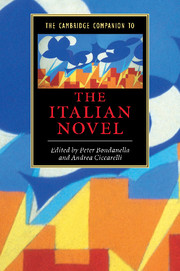Book contents
- Frontmatter
- 1 The belated development of a theory of the novel in Italian literary culture
- 2 The forms of long prose fiction in late medieval and early modern Italian literature
- 3 Alessandro Manzoni and developments in the historical novel
- 4 Literary realism in Italy
- 5 Popular fiction between Italian Unification and World War I
- 6 The foundations of Italian modernism
- 7 Neorealist narrative
- 8 Memory and testimony in Primo Levi and Giorgio Bassani
- 9 The Italian novel in search of identity
- 10 Feminist writing in the twentieth century
- 11 Italo Calvino and Umberto Eco
- 12 Literary cineastes
- 13 Frontier, exile, and migration in the contemporary Italian novel
- 14 The new Italian novel
- Index
- Series List
7 - Neorealist narrative
experience and experiment
Published online by Cambridge University Press: 28 May 2006
- Frontmatter
- 1 The belated development of a theory of the novel in Italian literary culture
- 2 The forms of long prose fiction in late medieval and early modern Italian literature
- 3 Alessandro Manzoni and developments in the historical novel
- 4 Literary realism in Italy
- 5 Popular fiction between Italian Unification and World War I
- 6 The foundations of Italian modernism
- 7 Neorealist narrative
- 8 Memory and testimony in Primo Levi and Giorgio Bassani
- 9 The Italian novel in search of identity
- 10 Feminist writing in the twentieth century
- 11 Italo Calvino and Umberto Eco
- 12 Literary cineastes
- 13 Frontier, exile, and migration in the contemporary Italian novel
- 14 The new Italian novel
- Index
- Series List
Summary
Origins, models, themes, language, and politics of neorealism
Neorealism as an object of study has turned out to be a puzzling problem of literary history. Elio Vittorini – an important neorealist novelist, editor of the interdisciplinary journal Il Politecnico (1945-7) that championed neorealism, and editor of “I Gettoni,” a series devoted to young writers published by Einaudi from 1951 to 1958 – maintained that each neorealist writer had his or her own neorealism. Pier Paolo Pasolini thought that what neorealists had in common was basically just a “taste” for the real. Some critics point to Gli indifferenti (The Time of Indifference, 1929) by Alberto Moravia, to Luce fredda (Cold Light, 1933) by Umberto Barbaro (1902-59), and to Tre operai (Three Workers, 1934) by Carlo Bernari (1909-92) as examples of early neorealist novels, but other critics cite Cesare Pavese's Paesi tuoi (The Harvesters, 1941) as the only proto-neorealist text before World War II. The term neorealismo was used occasionally in Italy in the 1930s to refer to new forms of realism (for example, the German Neue Sachlichkeit) then emerging in Europe in opposition to nonrealist movements such as expressionism, futurism, and symbolism. In Italy, modernist forms of realism flourished in the 1930s, ranging from the “magic realism” of Massimo Bontempelli (1878–1960) to the experimental fictions, tinged with surrealism, of Paola Masino (1908–89), to the existential novels of Moravia and Barbaro. Novels such as Maria Zef (Maria Zef, 1936) by Paola Drigo (1876–1938) testify to the enduring legacy of verismo and foreshadow the neorealist interest in the economic underdevelopment of many regions of Italy, particularly the South or the Mezzogiorno.
- Type
- Chapter
- Information
- The Cambridge Companion to the Italian Novel , pp. 104 - 124Publisher: Cambridge University PressPrint publication year: 2003
- 3
- Cited by



